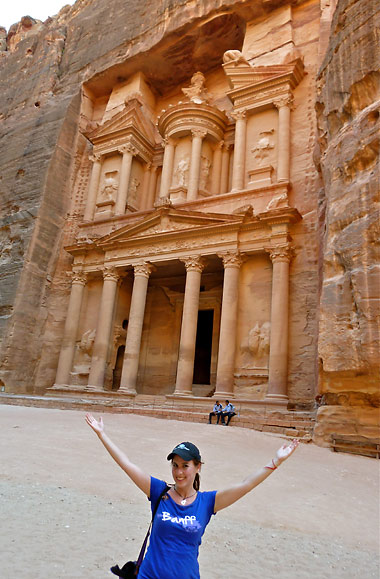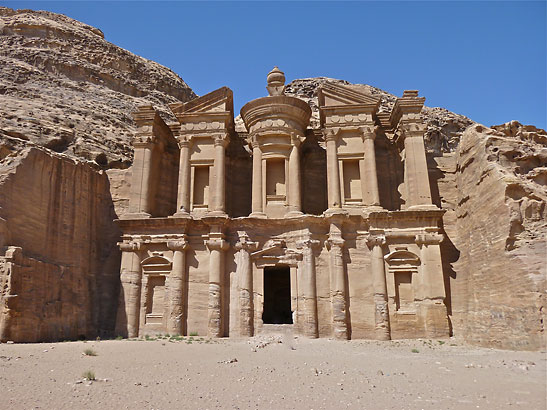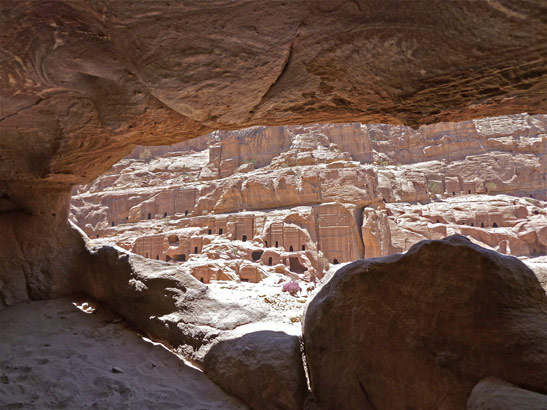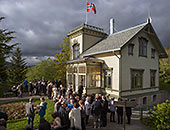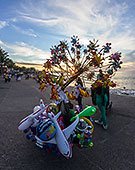 |
 |
|
 |

|
An Unlikely Adventure:
Petra, Jordan By Masada Siegel
Petra, the ancient secret city hidden for generations had also eluded me for years. I had made efforts in the past to go there only to be foiled at the last minute; instead of adventures in Jordan, I found myself in the emergency room. This time, regardless of the revolutions in the middle-east, and barring any other impending crisis, I was determined to make my dream come true, even going solo. I was at my namesake, Masada in Israel, an ancient fortress where the historic story of the last stand for a rebellious group of Jewish people fighting against the might Romans occurred when I met Janet. It was one of the first places in history where the people decided, "give me liberty or give me death. A three year battle ensued, and days before the Romans were to reach the top, the people decided to commit suicide rather than become slaves and captives. The group I was traveling in Israel was a grumpy, ok some were just downright nasty and in trying to avoid their negativity, I kept to myself. I thought about what my Mom has often told me, "Sometimes miserable situations can actually lead to positive ones." Although when in the midst of a situation where you happily consider pushing mean people off a mountain, it's hard to imagine. As the thought crossed my mind, I met Janet and Jen, two blond women, who rescued me from taking an all too close self portrait and offered to take a photo for me at a scenic spot. The connection was immediate and after chatting for five minutes we decided to travel to Petra, Jordan the following week. Through a series of emails and texts, we arranged the trip. Janet then called, Eco Tours, the company I was working with in Israel and told them, "Book me on whatever Masada is doing." We met again on the flight from Tel-Aviv to Eilat, where we then headed to the border. While walking in no mans land, suitcase in tow, Janet, a Tennessee native on her first international trip grinned and said, "This is so odd, I feel like I am in a movie. Oh and by the way what did you plan?" Upon arrival to the Jordanian side, soldiers with automatic machine guns checked our passports and we were escorted to meet Mohammad, our driver waiting in a black Mercedes. On the drive past Aqaba, we saw a new hospital being built and an army training facility. As we left the city towards Petra, it was through long stretches of desolate desert, dotted with the occasional Bedouin tent. As we got closer to Petra, the streets became curvy. We stepped out of the car, and met Abdul who guided us for the first three hours. Petra, a mythical city was hidden to the western world until 1812 when Swiss explorer Johann Ludwig Burckhardt rediscovered the ancient city carved into the red rocks. The city was established around the 6th century as the capital city of the Nabataeans who were a tribe who turned the city into an important link on the historic spice route trading extending from India to Syria to Eastern Africa.
Petra, became a UNESCO world heritage site in 1985 and the magic of generations past whispers to visitors as they walk through the entrance to the city, or the Siq. It's a narrow gorge, over 1km in length and surrounded on both sides by soaring, 80m high cliffs. The sophisticated water conduits system, which runs through the Siq is in between ancient works of art on the tall majestic narrow passageways. I felt like an ancient explorer, mesmerized by the phenomenal colors and formations. After about a twenty minute walk, the view at the end is where one sees the first glimpse of the breathtaking Al-Khazneh otherwise known as the "Treasury." The Treasury, carved out of the reddish-pink rock is a massive façade 30m wide and 43m high. It was carved in the early 1st century and was used as the tomb of an important Nabataean king. Petra is so astonishing also because the city was conquered and re-conquered by many different groups, each who left their mark in different ways. In 106 A.D the city was incorporated into the Roman Empire. The Roman influence is evident through many aspects, but especially through the broken Roman columns found on one of the boulevards called the Colonnaded Street. There is also a mosaic at the Petra Church, from the Byzantine time which is made of stone and glass cubes, featuring Greco-Roman designs.
Janet and I wandered for hours, into caves, atop hills, into rooms; once tombs brilliant with colors. We braved the 800 step climb through the afternoon heat of 100 degrees to see the Deir also know as the Monastery, another magnificent sculpture built into the rocks, at the top of a mountain. The views were endless, and the architecture unbelievable. It was easy to hear the ancient sounds of the busy merchants and the hustle and bustle of a city teeming with people. While now a place primarily for tourists, its energy makes history come alive. Petra was magical. It took years of perseverance, luck and timing. Even the misfortune of illness and terrible travel companions all led up to meeting a great person, Janet, to join me on my adventure. As we left Petra, amidst the sun setting, glistening over the reddish pink buildings, we stopped and watched the colors change. Janet turned to me and said, "Wow, what an adventure. Meeting you was a gift." I grinned, ok beamed, "And thank you" I laughed, "This unlikely adventure, totally random meeting, made this trip even better then I could imagine! Sometimes dreams really do come true in the most unusual of ways!" Masada Siegel can be reached at Fungirlcorrespondent@gmail.com © Masada Siegel, 2013 Related Arrticles: |
|
|
|
| ||||
|
| ||||
This site is designed and maintained by WYNK Marketing. Send all technical issues to: support@wynkmarketing.com

|







